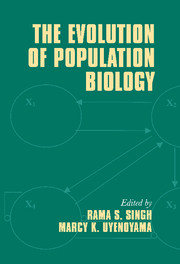Book contents
- Frontmatter
- Contents
- List of contributors
- Publications of R. C. Lewontin
- Preface
- Introduction
- Part I Historical foundations and perspectives
- Part II Genotypes to phenotypes: new genetic and bioinformatic advances
- Part III Phenotypes to fitness: genetics and ecology of populations
- Part IV Genes, organisms, and environment: evolutionary case studies
- Part V Applied population biology: biodiversity and food, disease, and health
- 17 Conservation biology: the impact of population biology and a current perspective
- 18 The emergence of modern human mortality patterns
- 19 Units of selection and the evolution of virulence
- 20 Evolutionary genetics and emergence of RNA virus diseases
- 21 A scientific adventure: a fifty years study of human evolution
- 22 Geneticists and the biology of race, 1900–1924
- Index
17 - Conservation biology: the impact of population biology and a current perspective
Published online by Cambridge University Press: 08 January 2010
- Frontmatter
- Contents
- List of contributors
- Publications of R. C. Lewontin
- Preface
- Introduction
- Part I Historical foundations and perspectives
- Part II Genotypes to phenotypes: new genetic and bioinformatic advances
- Part III Phenotypes to fitness: genetics and ecology of populations
- Part IV Genes, organisms, and environment: evolutionary case studies
- Part V Applied population biology: biodiversity and food, disease, and health
- 17 Conservation biology: the impact of population biology and a current perspective
- 18 The emergence of modern human mortality patterns
- 19 Units of selection and the evolution of virulence
- 20 Evolutionary genetics and emergence of RNA virus diseases
- 21 A scientific adventure: a fifty years study of human evolution
- 22 Geneticists and the biology of race, 1900–1924
- Index
Summary
A personal reflection
As a post-doctoral fellow with Dick Lewontin at the University of Chicago for the academic year 1968–1969, I attended the inspiring Tuesday and Thursday morning class on population biology he jointly taught with Dick Levins. With 20 to 30 post-docs, students, and other visitors listening intently to these lectures, we were all sure that population biology was an approach that would be widely adopted over the coming years. The lectures of this class were mainly on theoretical topics and generally focused on population genetics and somewhat less on population ecology. After my post-doc year at Chicago, I went to the University of Kansas where an upper-level undergraduate course in population biology was being developed. There I taught population biology over the next 19 years and wrote a text for the course entitled Population Biology: the Evolution and Ecology of Populations (Hedrick 1984). The connection of evolution and ecology using introductory theoretical population biology principles and illustrative biological examples worked well teaching undergraduates. The introduction to population biology 35 years ago at the University of Chicago greatly influenced my approach to science and was an important factor resulting in my concentration on conservation biology research in the past decade.
Brief history of conservation biology
In the latter half of the twentieth century, it was widely recognized that the rate of species extinction was increasing and that many species were in imminent danger of extinction.
- Type
- Chapter
- Information
- The Evolution of Population Biology , pp. 347 - 365Publisher: Cambridge University PressPrint publication year: 2004
- 1
- Cited by



